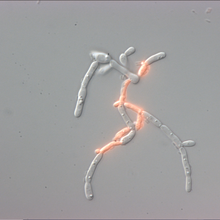A new front in microbial warfare – researchers explore a bacterial nano-weapon that targets pathogenic yeasts
07 September 2022

When it comes to disease-causing microbes, bacteria and viruses usually steal the spotlight. But there is another, often overlooked, microbial foe that is a grave cause for concern. Fungal pathogens cause an estimated 1.5 million human deaths and destroy a third of the global crop yield each year. Despite this impact on human health and food security, the number of antifungal drugs available is extremely limited.
Some scientists are exploring whether the key to new antifungal treatments could be gleaned from a different biological kingdom – bacteria. Many Gram negative bacteria possess a highly effective natural weapon which has recently been shown to kill pathogenic yeasts (a type of single-celled fungus).
This nano-weapon is the Type VI secretion system, which delivers effector protein toxins directly into target cells and kills them. “The Type VI secretion system is a very powerful bacterial weapon,” according to Janet Quinn, Professor of Eukaryotic Microbiology at Newcastle University, UK. “It uses a contraction-based mechanism to force a needle-like puncturing structure into neighbouring cells and inject effector toxin proteins.”
The Type VI secretion system is widely used by Gram negative bacteria to inject antibacterial effectors into rival bacterial cells. However, a few years ago, a breakthrough was made by postdoctoral researcher Dr Katharina Trunk, whilst in Professor Sarah Coulthurst’s laboratory at the University of Dundee, UK: the Type VI secretion system also produces antifungal effectors which can kill yeast.
In this work, two antifungal effector proteins were identified, called Tfe1 and Tfe2, which destabilise the yeast cells’ plasma membrane, or disrupt nutrient uptake, respectively. “It is a really new and exciting area of biology,” said Professor Quinn, adding: “It brings a new dimension to looking at bacterial–fungal interactions.
Following on from this discovery, a collaborative team of scientists from seven laboratories in the UK and Germany, have come together to explore how Gram negative bacteria use their Type VI secretion system to kill yeasts. The effector proteins’ precise mechanisms of action remains unknown, and so Professor Quinn, with help from the team, aims to unravel this mystery: “Understanding the mode of action of these potent antifungal effectors may pave the way for the development of new and much needed treatments to kill pathogenic fungi,” she said.
Professor Quinn’s team are delving into the mechanisms of action of antifungal effectors using various experimental techniques, including cell biology approaches and genetic screens to identify yeast mutants that are more sensitive or more resistant to the effector proteins. They also utilise proteomics and transcript profiling experiments to observe how yeast cells respond to the effectors at the protein and mRNA level. Revealing the cellular processes that the effectors disrupt may help identify novel targets for new treatments.
“Human fungal pathogens are a massively underappreciated health concern and the number of antifungal drugs that we have is extremely limited. There is also the growing problem of anti-fungal resistance in clinical isolates, which can render antifungal treatments ineffective, escalating the need for new drugs,” said Professor Quinn.
Professor Quinn also emphasises that the problem extends beyond human health: “The issue isn't restricted to disease-causing infections in humans, but also disease-causing infections in plants, which has a massive impact on world food security.”
More broadly, the understanding of how the Type VI secretion system targets yeast will also shed light on how yeasts and bacteria interact in the numerous polymicrobial environments where they naturally co-exist, from ecologically important environments such as within the soil, to medically relevant environments within the human host.
“We anticipate that this mechanism will be widespread and that the Type VI secretion system will shape many polymicrobial communities, including those that influence human health such as the gut microbiome,” said Professor Quinn.
Professor Janet Quinn will present this research at the Microbiology Society’s Focused Meeting, British Yeast Group 2022: From Genomes to Cells. Her talk, titled ‘Targeting a new kingdom: investigation into the mode of action of Type VI secretion system-elicited antifungal effectors’ will take place at 15:15 BST on Thursday 8 September 2022.
Image: Co-culture of Serratia marcescens bacteria with filamentous Candida albicans cells, with dead cells stained red. Credit: Katharina Trunk.
